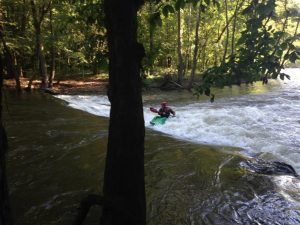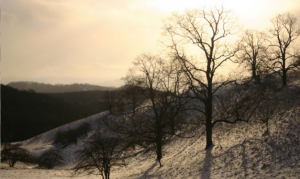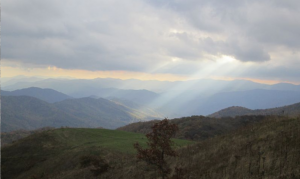The Blue Ridge Mountains are a paradise in the summer, alive with flowers and fireflies. But the blazing heat can sometimes feel brutal, driving many people indoors to the comfort of air conditioning. There’s no reason to stay cooped up when so many trails offer a respite from the soaring temperatures. Tucked inside the shade of rhododendron tunnels, deep within hardwood forests, and carved alongside roaring rivers, these six refreshing summer hikes allow you to beat the heat while savoring the full splendor of the season.
1. Laurel River Trail
A rejuvenating creekside hike just 45 minutes north of Asheville, this even, easy trail along Big Laurel Creek is very popular among locals. The trail is seven miles in its entirety, taking an average of 3.5 hours there and back, although hiking a shorter segment would still be a worthwhile excursion. The best part of your day will be the deep, aquamarine swimming holes that appear occasionally in the Big Laurel River, as well as the cooling mist and sunlit rainbows that arise from trailside waterfalls. Leave some extra time to explore the nearby no-traffic-light Appalachian Trail town of Hot Springs.
2. Boone Fork Trail

Joe Giordano
The heavy shade of rhododendron tunnels and a multitude of river crossings make the Boone Fork Trail the ultimate summer hike of the High Country. This should be your top pick if you are looking to head out of Asheville and explore the Appalachian region for an entire day. The 5-mile loop in Julian Price Memorial Park outside of Boone, North Carolina, is renowned for the variety of terrain that it passes through, which includes coniferous forest, open pastures, boulder gardens and flood plains filled with wildflowers. Slick river rocks, creek crossings and one cut-timber ladder adds a touch of challenge to the ever-changing landscape.
3. Four Falls

Melina Coogan
The 9-mile Four Falls Trail in DuPont State Forest provides a show-stopping tour of the area’s most dazzling mountain waterfalls. This spectacular loop will lead you to the base of Triple Falls, High Falls, and Bridal Veil Falls, and alongside the shoreline of cool, placid Lake Imaging. The hike concludes with a quick out-and-back jaunt from the trailhead to Hooker Falls, one of the most popular swimming holes in the Blue Ridge Mountains. Between waterfalls, the trail winds through deep woods and shaded rhododendron tunnels, providing relief from the relentless summer sun. Park at the Hooker Falls trailhead.
4. Craggy Gardens

Parke Ladd
Due to the elevation, the temperature atop Craggy Gardens is about 5-20 degrees cooler than it is in Asheville. Slabs of slate gray rock and bright pink rhododendron blooms create a vivid landscape, surrounded by panoramic 360 degree views of Asheville, Mt. Mitchell, and the endlessly undulating Blue Ridge Mountains. A mere 1.4 mile loop, this is a great starter trail for kids: quick, steep without being overly demanding, with a dramatic mountain top finale that’s perfect for picnics. This hike could be combined with other attractions on the Blue Ridge Parkway such as Graveyard Fields and Skinny Dip Falls for a full day of warm weather exploration.
5. Max Patch at Night

Marcos Gasc
While we would be remiss to not mention Max Patch as a breathtakingly beautiful summer destination, we’ll concede that its immense popularity could be a deterrent for many hikers. The solution? Visit this enormous Appalachian meadow at night, when the masses have gone home and the sky is so illuminated with lightning bugs that you can capture their glow on camera using a long exposure, as you would the constellations. Pack a blanket for some summer stargazing directly up the hill from the parking area or enjoy the cool evening air with a moonlit hike on the Appalachian Trail.
6. Daniel Ridge Loop Trail

Johnny Dickerson
Those of us who love pouring over a good, old fashioned map may be confused by the name of this four mile trail, which is actually located on a spur of Lanning Ridge. Misnomers aside, the Daniel Ridge Loop Trail is a lovely and scenic hike which meanders through 50-year-old hardwoods and bucolic pastures enveloped inside Pisgah National Forest. Sections of steep hillside provide a good workout, but a thick canopy of hemlock and arching mountain laurel dapples and deflects the full glare of the midday sun. The end of the trail criss-crosses over a roaring creek on a series of planks and wooden bridges, until it reaches the base of the monolithic, 100-foot Toms Springs Falls.
Featured image provided by Steven Reinhold






































